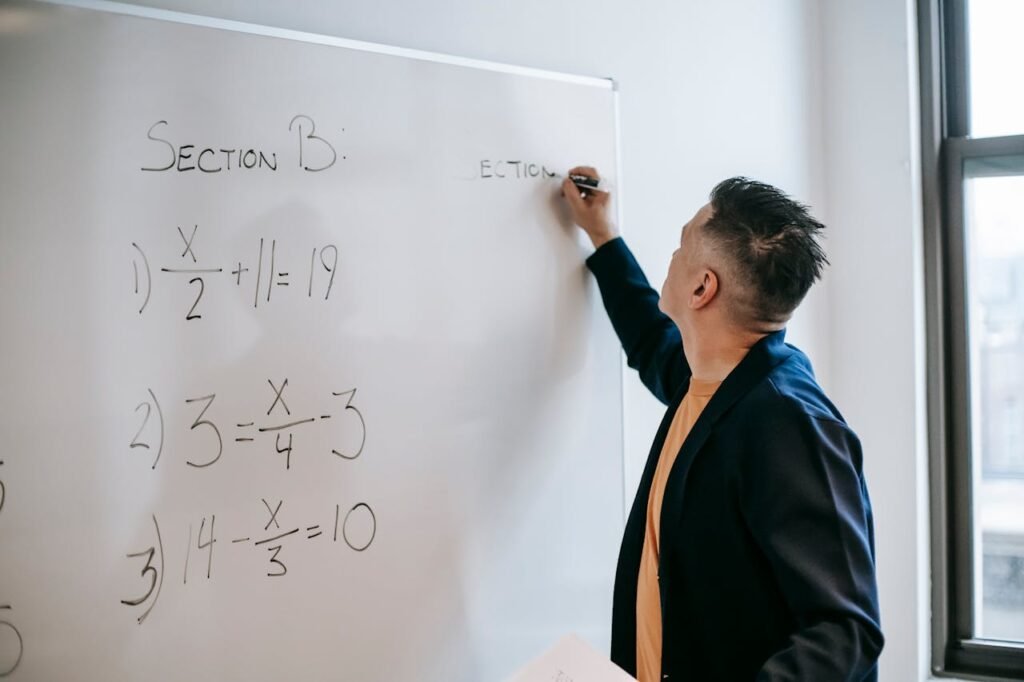PSLE Maths can seem scary at first — it’s an important exam that prepares your child for maths in secondary school. But with the right tips and regular practice, it can become much easier.
Simple methods like “working backwards”, good time management, and revising basic topics can all help your child feel more confident and do better in the exam.
At Descartes Learning Centre, we’ve helped over 100 students get AL1 grades since 2022. Over the years, we’ve found useful tips that really work, and we’ve shared them below to help your child do well in PSLE Maths.
13 PSLE Maths Tips
1. Relearn the Basics Using Primary 4 Concepts
PSLE Maths is built on earlier blocks of knowledge – weak foundations in Primary 4 concepts like fractions, factors and multiples, or basic percentage can lead to struggles when facing more advanced PSLE maths questions. Many of these appear in Booklet B of the math paper, especially in multi-step problems.
A pro-tip? Use items like Legos, or paper models to reintroduce these concepts in a tactile, engaging way for your child.
For example you can, split a bar of chocolate into 8 parts to illustrate fractions. These practical examples help reinforce what can feel like abstract ideas to children.
2. Create a “PSLE Mistake Tracker” Notebook
One of the most effective ways to reduce careless mistakes is by maintaining a dedicated “mistake journal.” Each time your child completes a PSLE math paper or practice worksheet, have them note down any errors: not just what went wrong, but why it happened.
Did they misread the question? Apply the wrong formula? Make a calculation slip? Categorising mistakes helps spot patterns and focus future revision sessions.
You can encourage your child to review this notebook weekly – it will be their secret weapon for PSLE success.
3. Teach Them to “Work Backwards” on Problem Sums
The “work backwards” method is critical for solving many P6 problem sums. For example, if a child spends ⅗ of his money and ends up with $24, it’s not about guessing—it’s about reconstructing the steps logically.
Practise this technique using real-life money problems. Let your child be the “shopkeeper” and simulate transactions using this approach. By reframing problems into relatable scenarios, they’ll not only master this method but become faster and more accurate.
Example Problem:
Ali spent ⅗ of his money on a toy. Then he gave $8 to his brother. He had $24 left. How much money did Ali have at first?
Step-by-Step Breakdown:
- Understand the Story Flow (Annotation Phase):
- Ali spends part of his money → gives away $8 → ends with $24.
- The $24 is after all deductions.
- The ⅗ refers to the initial spending.
- Ali spends part of his money → gives away $8 → ends with $24.
- Reverse the Final Step:
If Ali gave $8 away after spending, then:- Before giving $8, he had:
$24 + $8 = $32
- Before giving $8, he had:
- Now Reverse the Fraction Operation:
He spent ⅗ of his original amount, so what’s left is ⅖. That means:- ⅖ of his original money = $32
- To find the full amount (5/5), calculate:
$32 ÷ 2 × 5 = $80
- ⅖ of his original money = $32
- Answer:
Ali had $80 at first.
4. Use Coloured Pens to Break Down Word Problems
To tackle long problem sums, teach your child to underline or colour-code:
- Important numbers and units (e.g. “24 litres”)
- Operations or keywords (e.g. “more than,” “shared equally”)
- Final question prompts (e.g. “how much left?”)
This visual strategy reduces the feeling of being overwhelmed and enhances reading the question, which is a skill vital in any exam. It’s especially useful in maths exam conditions when stress levels are high and clarity is crucial.
5. Explain Model Drawing Using Real-Life Examples
Don’t just teach bar models, make them real. Use actual bars of chocolate or blocks to physically build models with your child. Show how “3 parts for Sarah, 2 parts for Ben” might look, then translate it to a drawing.
When children grasp that models are just simplified visual representations of real-world quantities, it makes those “tricky” PSLE maths questions much more approachable.
6. Practise Mental Estimation
Even though calculators are allowed in Paper 2, mental estimation helps children check their answers quickly. Ask questions like:
- “Is 73 x 8 closer to 500 or 600?”
- “Can ½ of 360 be more than 200?”
This sharpens number sense and helps avoid glaring errors like “1240cm tall” answers. It also improves their speed and accuracy, which are vital for managing the math exam paper within time limits.
7. Master Time Management with the “1 Minute per Mark” Rule
Teach your child to pace themselves with this formula: one minute per mark. That means spending about 10 minutes on a 10-mark section, not more. For Paper 1, they should aim to complete Booklet A in 20 minutes, leaving time to double-check answers.
This strategy promotes good time management and avoids panic, especially in math paper 1 where short-answer questions can eat up more time than expected.
8. Utilise Past Year Papers for Familiarity
Working on actual PSLE math papers under exam conditions familiarises your child with the pacing, structure, and types of different questions they’ll face. Mark and review each paper thoroughly – you can use a red pen to mark corrections and a green pen for key learning points.
Also, focus on identifying the challenging questions often found in the last few slots of Paper 2.
9. Focus on Understanding Concepts Over Memorisation
It’s not enough to memorise formulas. Children must understand when and how to apply these concepts. For example, instead of just learning the formula for volume, let them measure water using different containers.
Practical, real-life applications build a good understanding that sticks, even when a tricky question is reworded or hidden in a story.
10. Incorporate Short, Regular Revision Sessions
Don’t overwhelm your child with long hours of study. Instead, aim for short 30-minute sessions focusing on one concept at a time, such as speed, average, or ratios.
Use a mix of written problems, mental drills, and timed practices. This promotes consistent practice, which is more effective than cramming and avoids burnout.
11. Use the “Last 5 Questions” Challenge
Train your child to tackle the hardest part of the math paper with confidence. The last 5 questions in Paper 2 are usually multi-step and logic-heavy. Working on these regularly builds analytical thinking.
Even if they don’t get them right every time, they learn how to break complex problems into smaller parts – a crucial skill for top scorers.
12. Use the “Checkpoint Timer” for Paper 1
Simulate exam timing at home. Start with 20 minutes for Booklet A, then spend the rest on Booklet B with at least 15 minutes to check.
Time awareness is vital. A child who doesn’t keep an eye on the clock might spend 8 minutes on a 1-mark question, leaving tougher 5-markers unanswered.
13. Design a Personal Formula Booklet
Let your child create their own formula book—a one-stop place for all maths exam essentials: area, volume, speed, percentage increase, and more.
Add sample questions and colour-code the sections. Reviewing this booklet weekly reinforces learning and gives them a self-made PSLE maths guide for revision.
How Early Should You Prepare for PSLE?
We recommend starting targeted preparation from Primary 5, with gradual exposure to complex problem types.
However, even in Primary 6, it’s never too late. With structured practice, review, and smart strategies like the ones above, your child can make significant gains in a few months.
How to Plan a PSLE Revision Timetable?
Break the week into subject blocks. For math, include:
- Concept review (e.g., fractions, area)
- Timed practice (Paper 1, Paper 2)
- Error analysis
- Formula review
- Mixed-topic drills
Balance is key. Ensure downtime, mix in PSLE Science and English, and adjust weekly based on progress. Include one “fun” day for games, puzzles, or rest.
FAQ
How can I help my child with PSLE Math if I don’t remember the methods?
Start by watching video solutions or using online PSLE math guides. You don’t have to teach—just guide and support. Let your child explain the concepts to you. This builds understanding and reinforces what they learn.
What’s the best way to improve speed and accuracy for PSLE Math?
Use the “1 mark = 1 minute” rule, practise short-answer questions, and build a habit of checking answers. Encourage your child to estimate answers, so obvious errors stand out.
How often should we revise a topic?
Try the “3-pass” rule – first to learn, second to reinforce, third to test under pressure. Revisit difficult areas weekly, and build in enough practice before exams.
From not only passing to excelling in PSLE maths, we at Descartes Learning Centre having your child covered.
We offer one-on-one lessons, with proven results. Contact us today!



